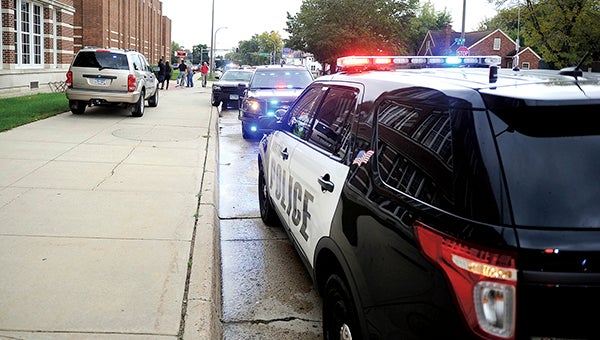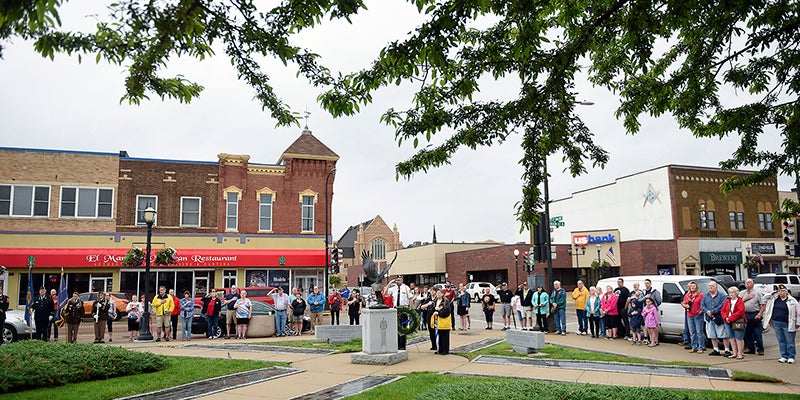Planning for the worst
Published 6:59 pm Friday, February 4, 2022

- Austin Police and Mower County Sheriff’s Department vehicles gathered outside Austin High School in September 2015, after an altercation outside a southwest exit. Even though it was fight and not a shooting, law enforcement and schools have ever changing plans on how to deal with increased violence should it ever come. Herald file photo
|
Getting your Trinity Audio player ready...
|
In the wake of the Richfield shooting this week, local law enforcement and schools reflect on emergency plans
Questions remain following this week’s shooting at a Richfield school, that left one dead and another critically injured.
It brings up the same questions of why and what could have been done to either stop it or prevent it, but it also raises questions within law enforcement circles across the state as well as in schools.
It prompts reviews of procedures.
“Initially, as a human you feel for everybody involved,” said Mower County Sheriff Steve Sandvik. “From a law enforcement perspective you go back to, are we prepared? We do always train for that, you just hope that it’s not in your area. You learn lessons from each and every one of those. It’s immediately on our radar. What do we do to improve? How do we protect people?”
Austin and the area have fortunately avoided such instances of violence at schools, but it hasn’t been completely free of violence. In late September 2015, Austin Police were dispatched to Austin High School for a fight involving a large number of people on the southwest side of the school.
The fight caused a lockdown of the school for a brief period of time and there had even been a report of a gun, though that was never substantiated.
Still, it raised a specter of unfortunate incidents across the country that did involve guns and ended tragically.
It’s why schools will constantly review their own policies.
“We work with our security team and crisis team. We use a variety of scenarios: bad weather, gas leak and along those same lines is a shooting,” said APS Superintendent Dr. Joey Page. “We review those, work through exercises involving law enforcement.”
It’s that close relationship with law enforcement that helps schools like APS be prepared for any eventuality, such as a shooting.
APD has placed a pair of liaison officers into Austin High School and at IJ Holton Intermediate School and Ellis Middle School for a number of years. While people in other parts of the nation have raised questions as to whether or not liaison officers are a boon or detriment to schools, there is little doubt in Austin Police Chief David McKichan’s mind that they have helped Austin’s schools.
“Officers get to know the kids. That’s very important,” McKichan said. “When we bring one of the patrol officers into the school, they’re not going to have relationships with the school and staff. Having officers that know the kids individually and know what their needs are, they developed that relationship … it really goes a long way to safely de-escalate situations.”
However, the scenario might be a little different in the outlying communities, where distance can play a part. With deputies in different parts of the county, cooperation with different law enforcement agencies becomes even more important.
“We basically have dispatch request mutual aid from the State Patrol and maybe even Iowa authorities,” Sandvik said.
That raises the importance of training with multiple agencies, as well as fire departments, ambulance and first responders.
Normally, agencies such as APD and the Mower County Sheriff’s Department try to have training at least every other year. The COVID-19 pandemic has made that more difficult, but the effort is still made to make sure that everybody responding to an incident knows what to do when they get there.
While a crime of violence might be slightly different either at a school or a business, McKichan said the response is largely the same: Make sure the scene is secure and as safe as they can make it.
“Now we’re really going into emergency medical mode,” McKichan said. “Make sure EMS and fire can safely enter the scene. Usually there is a mix of investigative pieces.”
“If we can ascertain the scene is safe, violence is not going to be ongoing, we’re trying to treat those victims at the scene, making sure those partners can come in,” he added.
Training will often take place in the school itself and serves to continually update how law enforcement may respond to certain scenarios.
This includes not only the crime itself, but the chaos that can ensue. One of the biggest challenges that law enforcement has faced over the years is trying to find organization in that chaos.
Is the shooter still in the school, or did they leave with students evacuating the school? It’s the same for other incidents where there may be large crowds.
“Years ago that might have been at bar close and it carries with it an element of chaos,” McKichan said. “You’re obviously going to have multiple witnesses and you’re trying to understand what they saw. There’s competing interest from those in the crowd.”
One thing that has emerged over the years is schools taking an active role in the prevention of incidents like the one that happened in Richfield this week. Putting a sense of control in the hands of those who may deal with something before law enforcement.
“That’s the best thing — touching base with the schools, making sure their counselors are networking,” said Sandvik. “They know to call if they have a concern about something. If you see something, say something.”
Part of that preventive measure is understanding the role mental health possibly plays in incidents like this. It requires a constant awareness of what might be going on in a school.
“We need to continue positive connections with the schools and continue to encourage them to say something and not be afraid we’re not going to over blow it. Just get some involvement,” Sandvik said.
Page agrees.
“I think one of our key strategies is being prepared,” he said. “Our security team and crisis team review incidents that may occur and coordinate with law enforcement and stay vigilant. That is key.”




